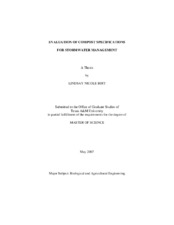| dc.description.abstract | Urban development will continue to increase in Texas because of population growth and urban sprawl. Despite the desire for urbanization and expansion of the economy, this growth increases the amount of construction, which, if not properly managed, can increase non-point source pollution and threaten surface water quality. Therefore, Texas Department of Transportation (TxDOT) has approved and promoted the use of compost as a stormwater best management practice (BMP) during highway construction. The objectives of this study were to construct and calibrate an indoor rainfall simulator and to determine the effectiveness of using compost rather than conventional hydroseeding or topsoil to reduce erosion from disturbed soils. Runoff rates, interrill erosion, and interrill erodibility were determined and compared across five compost treatments following TxDOT specifications for compost applied as an erosion control and two control treatments of topsoil (TS) and hydroseeding (HS) applied at 5 cm depth. The simulator produced 89% uniformity using ten Veejet 80100 nozzles at a target rate of 100 mm h-1. The surface runoff was collected after 5 minutes of rainfall (first flush) and during the last 30 minutes of rainfall (steady-state). The first flush mean runoff for GUC-5 treatment was significantly higher than all other treatments. All other treatments; 50% woodchips and 50% compost blend (ECC-1.3, ECC-5), and hydroseeding (HS) had significantly lower runoff and erosion rates compared to topsoil (TS) and compost manufactured topsoil (CMT) at first flush and steady-state. Furthermore, there were no performance differences between 1.3 cm and 5 cm compost applications at first flush or steady-state. The results of this project indicate that particle size, soil moisture capabilities, and time at which rainfall is applied affect surface runoff. TxDOT specification of using ECC at 5 cm depth on a max of 3:1 slope should be reconsidered. An ECC application depth of 1.3 cm was effective in reducing first flush runoff and interrill erosion rates. | en |


